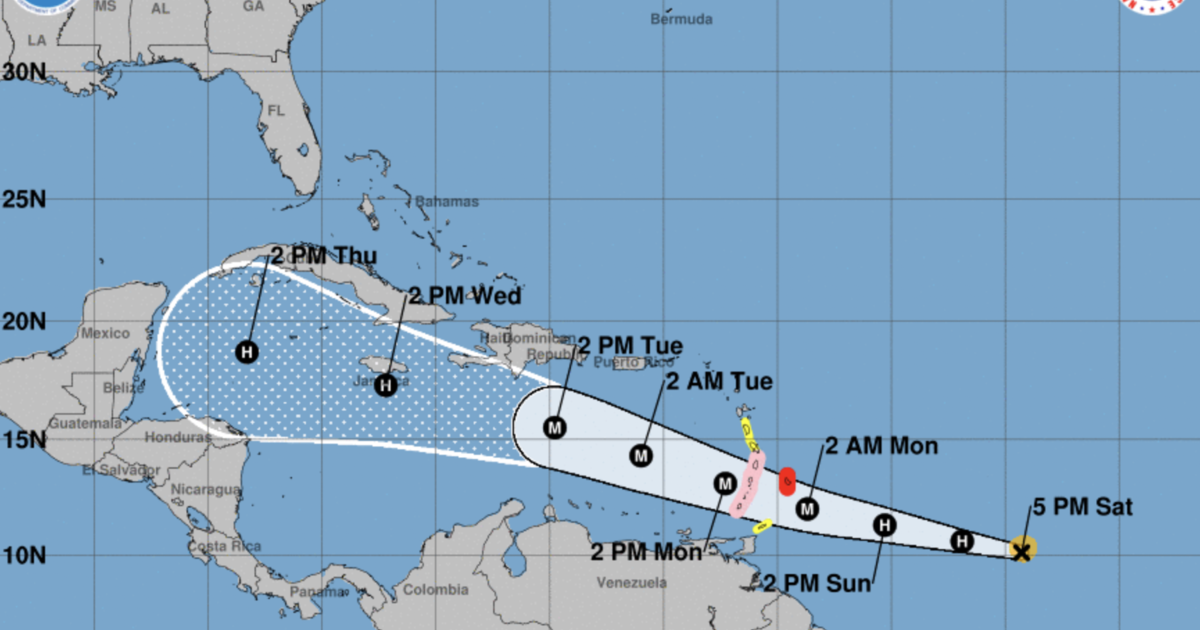Hurricane Beryl’s Projected Path and Intensity
:quality(70)/cloudfront-us-east-1.images.arcpublishing.com/cmg/AWHDX4GIS6ELRDN2KSNZFDACQU.jpg)
Hurricane beryl forecast – Hurricane Beryl is currently located approximately 100 miles east of the Lesser Antilles, moving west-northwest at 15 mph. The storm is expected to continue on this track for the next 24 hours, gradually turning more towards the northwest. Beryl is forecast to strengthen into a Category 2 hurricane by tomorrow morning and could reach Category 3 status by Wednesday.
Di forecast a seh Hurricane Beryl a guh pass close to Jamaica, so it important fi stay prepared. Yuh can check di latest updates and warnings fi hurricane beryl jamaica online. Remember, safety first!
Projected Path, Hurricane beryl forecast
The latest forecast track from the National Hurricane Center shows Beryl passing just north of the Virgin Islands and Puerto Rico by Tuesday evening. The storm is then expected to continue on a northwestward trajectory, passing near or over the Turks and Caicos Islands by Wednesday morning. Beryl is then forecast to turn more towards the north, paralleling the east coast of Florida by Thursday morning.
Hurricane Beryl is expected to bring heavy rainfall and strong winds to the southeastern United States. The storm is currently located in the Gulf of Mexico and is moving northwest. Forecasters are still tracking the storm’s path, but it is expected to make landfall somewhere along the Gulf Coast.
To get the latest information on where Beryl is headed, visit where is beryl headed. The National Hurricane Center is also providing updates on the storm’s progress.
Potential Changes
There is some uncertainty in the forecast track of Hurricane Beryl, as the storm could be influenced by a developing trough of low pressure to the north. If the trough deepens, it could cause Beryl to turn more towards the northeast, bringing it closer to the Bahamas and the southeastern United States. However, if the trough remains weak, Beryl is likely to continue on its current track.
Potential Impacts and Evacuation Zones: Hurricane Beryl Forecast

Hurricane Beryl poses significant threats to affected areas. Understanding the potential impacts and taking appropriate evacuation measures is crucial for safety.
The storm’s strong winds can cause widespread damage to buildings, infrastructure, and vegetation. Flooding from heavy rainfall and storm surge can inundate coastal areas, roads, and low-lying regions, leading to property damage, disruption of transportation, and potential loss of life.
Evacuation Zones
Authorities have designated evacuation zones based on the projected path and intensity of Hurricane Beryl. Residents in these areas should be prepared to evacuate promptly if ordered.
- Zone A: Coastal areas with high risk of flooding from storm surge and high winds.
- Zone B: Areas adjacent to Zone A, with moderate risk of flooding and wind damage.
- Zone C: Inland areas with potential for flooding and wind damage, but at lower risk than Zones A and B.
Shelters and Resources
For those who need to evacuate, shelters will be available in designated areas. Residents should bring essential items such as medications, important documents, food, water, and a battery-powered radio.
Additional resources, including transportation assistance and financial aid, may be available to support evacuees. Contact local authorities or visit official websites for more information.
Monitoring and Communication

Monitoring the progress of Hurricane Beryl is crucial for safety and preparedness. Official sources, such as the National Hurricane Center (NHC), provide real-time updates on the storm’s path, intensity, and potential impacts. Staying informed and following safety guidelines is essential to minimize risks and protect life and property.
Official Sources for Monitoring
- National Hurricane Center (NHC): www.nhc.noaa.gov
- National Weather Service (NWS): www.weather.gov
- Local news and media outlets
- Emergency management agencies
Importance of Staying Informed
Staying informed allows you to make informed decisions about your safety. By monitoring the storm’s progress, you can:
- Stay ahead of the storm and evacuate if necessary
- Prepare your home and property for potential impacts
- Be aware of potential hazards, such as flooding, wind damage, and power outages
- Follow instructions from emergency officials
Role of Social Media and Community Networks
Social media and community networks can play a vital role in sharing information and providing support during a hurricane. However, it’s important to be cautious and rely on credible sources.
- Share official updates and safety guidelines
- Connect with others in your community to provide and receive assistance
- Report storm damage or request help
- Stay connected with loved ones